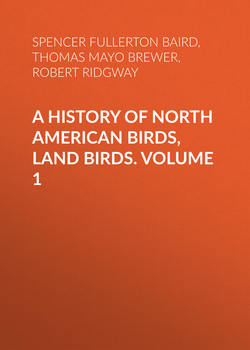Читать книгу A History of North American Birds, Land Birds. Volume 1 - Robert Ridgway - Страница 12
NORTH AMERICAN BIRDS
Family CHAMÆADÆ.—The Ground-Tits
ОглавлениеChar. Bill compressed, short, rather conical, not notched nor decurved. Culmen sharp-ridged. Nostrils linear, with an incumbent scale. Rictal bristles reaching beyond nostrils, which are scantily overhung by bristly feathers. Loral feathers bristly and directed forwards. Tarsi booted, or covered with a continuous plate anteriorly, with faint indications of scutellæ on the inner side. Basal joint of middle toe attached for about half its length on either side. Primaries ten; sixth quill longest. Plumage very lax.
Chamæa fasciata.
5924
We have found it impossible to assign the genus Chamæa to any recognized family of American birds, and have accordingly been obliged to give it independent rank in this respect, although it may properly belong to some Old World group with which we are not acquainted. In its general appearance it approaches the Paridæ in loose plumage, bristly lores, want of notch to bill, etc.; but differs in the very much bristled rictus, sharp-ridged culmen, linear nostrils, booted tarsi, less amount of adhesion of the toes, etc. It approaches the Sylviidæ in the sharp-ridged culmen and bristly gape, but is otherwise very different. The excessively rounded wing is a peculiar feature, the sixth primary being the longest.
Chamæa fasciata.
The family may, perhaps, be best placed between the Sylviidæ and Paridæ.
This family has but one representative (Chamæa fasciata), and this confined to the coast region of California. The characters of the genus are those of the family.
Genus CHAMÆA, Gambel
Chamæa, Gambel, Pr. A. N. Sc. Phil. III, 1847, 154. (Type, Parus fasciatus.)
But one species of this genus has as yet been described.
Chamæa fasciata, Gamb
GROUND-TIT; WREN-TIT
Parus fasciatus, Gambel, Pr. A. N. Sc. Aug. 1845, 265 (California). Chamæa fasciata, Gambel, Pr. A. N. Sc. III, 1847, 154.—Ib. J. A. N. Sc. 2d series, I, 1847, 34, pl. viii, fig. 3.—Cabanis, Wiegmann’s Archiv, 1848, I, 102.—Cassin, Illust. I, 1853, 39, pl. vii.—Baird, Birds N. Am. 1858, 370.—Ib. Review, 76.—Cooper, Birds Cal. 1, 39.
Sp. Char. Wings scarcely two thirds the length of the tail; both very much graduated. Upper and outer parts generally (including the whole tail) olivaceous-brown, tinged with gray on the head; beneath pale brownish-cinnamon, with obsolete streaks of dusky on the throat and breast. Sides and under tail-coverts tinged with olive-brown. Lores and a spot above the eye obscurely whitish. Tail-feathers with obsolete transverse bars. Total length, 6.20; wing, 2.30; tail, 3.50, graduation, 1.20; exposed portion of first primary, .85, of second, 1.30, of longest, sixth (measured from exposed base of first primary), 1.80; length of bill from forehead, .52, from nostril, .30; along gape, .60; tarsus, 1.05; middle toe and claw, .78; claw alone, .23; hind toe and claw, .55; claw alone, .30. Eggs light blue, unspotted; nest on low bushes.
Hab. Coast region of California.
Habits. This very interesting species, which seems to combine within itself the principal characteristics of the Wren and the Titmouse, was first described by the late Dr. Gambel of Philadelphia. So far as is now known, it is confined to the coast country of California, from Fort Tejon to the shore and from San Diego to the Sacramento. Dr. Gambel’s attention was first directed to it by the continued sound of a loud, crepitant, grating scold which he was constantly hearing in fields of dead mustard-stalks and other similar places. He at last discovered it to be this species, which from its peculiar habits he called a Wren-tit. It kept close to the ground, was difficult to be seen, and eluded pursuit by diving into the thickest bunches of weeds, uttering, when approached, its peculiar grating wren-like notes. When quietly watched it could be seen to search for insects, climbing twigs and dry stalks sideways, jerking its long tail, or holding it erect in the manner of a wren, which, in this position, it very much resembles. He describes it as at times uttering a slow, monotonous singing note like a chick-a-dee, represented by pee-pee-pee-peep. At other times its song is a varied succession of whistling. In spring it was heard, in pairs, calling and answering, in a less solemn strain, and in a manner not unlike a sparrow, with a brief pit-pit-pit, ending with a prolonged trill. If disturbed, they at once resumed their usual scolding cries.
Mr. Bell found this species chiefly frequenting damp places, and speaks of it as of pert habit, and not easily frightened. Its white iris, when observed in its native retreats, makes it easily recognized. This feature is as conspicuous in this bird as it is in the White-eyed Vireo. Its skin is remarkably strong, the muscles of the thighs powerful and well developed, and its whole muscular system exhibits an unusual strength and firmness.
Dr. Cooper’s observations in regard to this bird are a little different in some respects. He found it common everywhere west of the Sierra Nevada on dry plains and hillsides, among the shrubby undergrowth, but not in the forests. Instead of preferring damp places, he found it living where there is no water, except occasional fogs, for six or eight months at a time. Their movements can be observed by patient watching and keeping perfectly quiet, when they seem attracted by curiosity to such a degree as to approach one within a few feet, and fearlessly hop round him as if fascinated.
Dr. Cooper found their nests near San Diego built about three feet from the ground in low shrubs. They were composed of straw and twigs mixed with feathers and firmly interwoven. The cavity, about two inches wide and an inch and three fourths deep, is lined with grass and hair. The eggs, three or four in number, are of a pale greenish-blue, and measure .70 by .52 of an inch.
